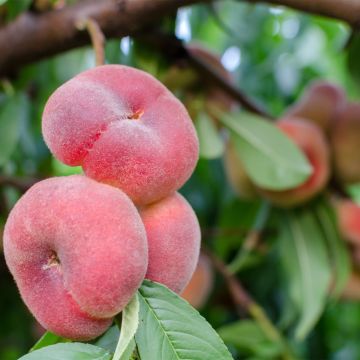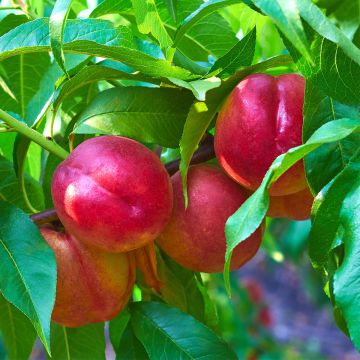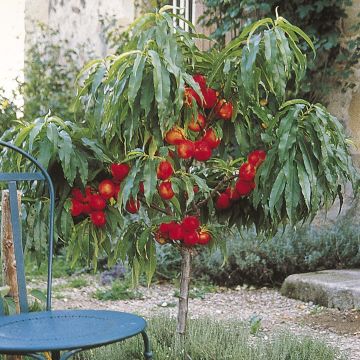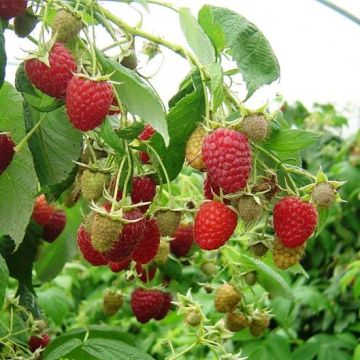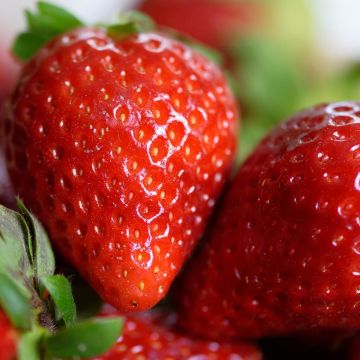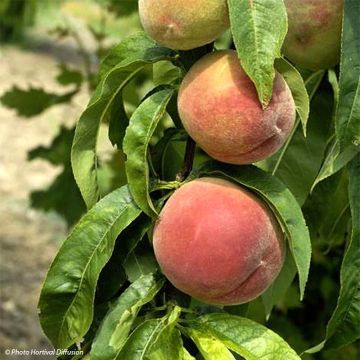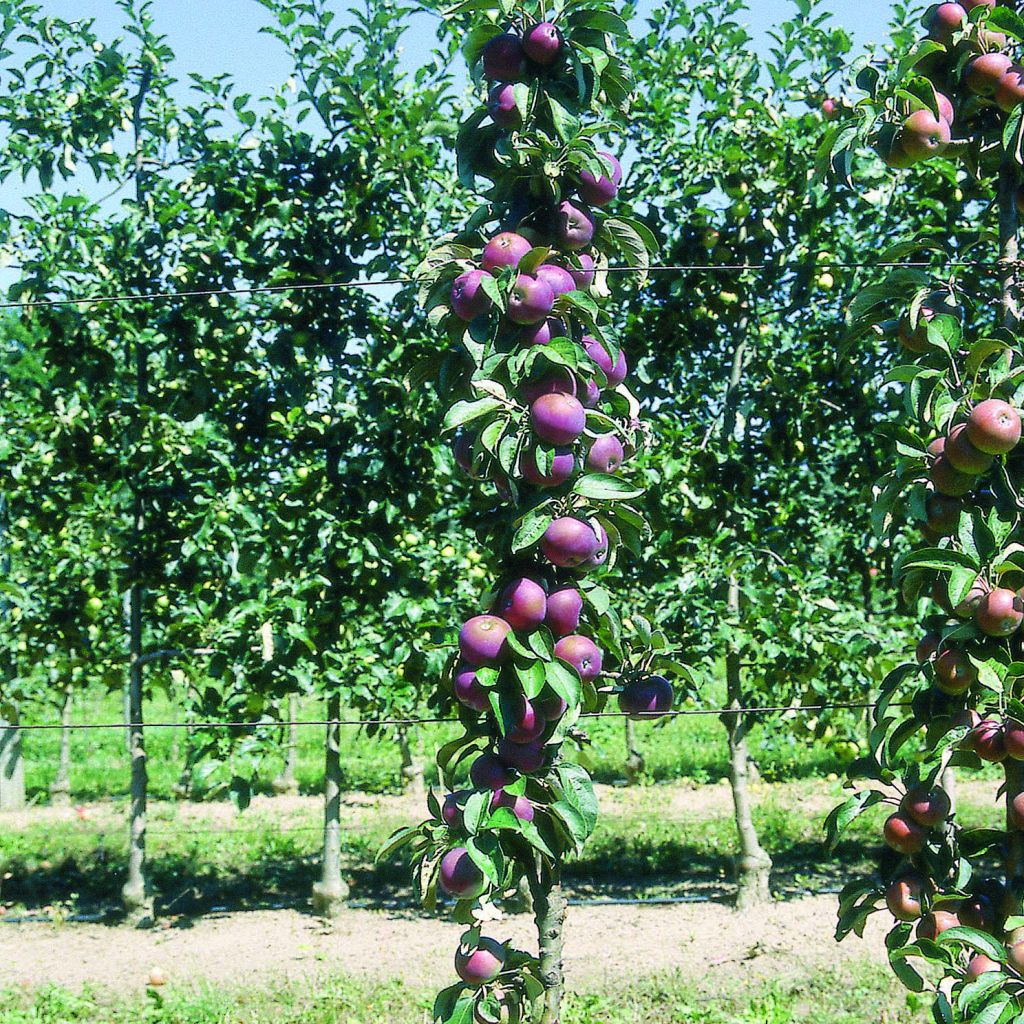

Columnar Apple Tree Chinon - Georges Delbard
Columnar Apple Tree Chinon - Georges Delbard
Malus domestica Chinon® Delcoblu
Apple, Orchard apple, Table apple, Cultivated apple
Special offer!
Receive a €20 voucher for any order over €90 (excluding delivery costs, credit notes, and plastic-free options)!
1- Add your favorite plants to your cart.
2- Once you have reached €90, confirm your order (you can even choose the delivery date!).
3- As soon as your order is shipped, you will receive an email containing your voucher code, valid for 3 months (90 days).
Your voucher is unique and can only be used once, for any order with a minimum value of €20, excluding delivery costs.
Can be combined with other current offers, non-divisible and non-refundable.
Home or relay delivery (depending on size and destination)
Schedule delivery date,
and select date in basket
This plant carries a 6 months recovery warranty
More information
We guarantee the quality of our plants for a full growing cycle, and will replace at our expense any plant that fails to recover under normal climatic and planting conditions.
Description
The Chinon® delcoblu Columnar Apple Tree is an excellent variety known for the beautiful colour of its fruits. It is perfectly suited for small gardens and growing in large pots on the terrace. With a maximum height of 4 metres (13 feet), it can easily be contained at a height of 2 metres (7 feet). Very productive and fast-growing, it quickly bears fruit and offers medium-sized apples with an exceptional colour: a beautiful bluish pink tinged with violet. Almost as delicious as they are beautiful, their flesh reveals a perfectly balanced flavor between tart and sweet.
These fruits are harvested in late summer, from August to September, and can be consumed immediately until October.
Hardy, the Chinon® Columnar Apple Tree can withstand temperatures as low as -20°C (-4°F) and usually blooms in April-May. It is a vigorously growing and fast-fruiting variety that produces its first apples 2 to 3 years after planting, sometimes even earlier. It is also resistant to diseases.
This apple tree, like all espaliered forms, requires staking.
Decorative and space-saving, it only requires about 60cm (24in) in width. Like dwarf apple trees, columnar forms are ideal for small gardens, as well as in large pots on the terrace. They can also be easily installed along the edge of a vegetable garden or even in the middle of vegetables, as they do not create too much shade. Finally, this type of fruit tree is very practical because the fruits are easy to pick.
The Chinon® Columnar Apple Tree is not self-fertile, so in order to bear abundant fruit, it should be planted near varieties that bloom at the same time, such as the 'Reine des Reinettes', which is present in many gardens.
The apple tree (Malus pumila or domestica) is a fruit tree belonging to the Rosaceae family. It is cultivated almost everywhere in the world and includes countless varieties, both old and modern, that produce apples of varying sizes and flavours.
Apple trees are native trees in Europe, including France, where their presence has been documented since ancient times. They are hardy, with some varieties able to withstand temperatures as low as -30°C (-22°F), and can be grown almost everywhere.
The size of the domestic apple tree does not exceed ten metres in height, with a similar width. However, the size can be much smaller depending on the vigour of the rootstock used. This fruit tree usually has a tall trunk that naturally spreads out. It comes in different forms (bush, half-standard, standard...) and can be trained in many ways (columnar, cordon, espalier...)
Apple tree leaves are deciduous and alternate on the branches. They have an oval and toothed lamina. The upper surface is dark green and the lower surface is whitish and slightly fuzzy.
In spring, apple trees bear white or pinkish-white flowers grouped in corymbs. Apple flowers consist of 5 petals, surrounding a center composed of about 20 stamens. They give rise to fleshy fruits (drupe, from a botanical perspective), spherical and filled with pips. Their colour, size, flavour, and shelf life vary depending on the variety.
Rarely self-fertile, the apple tree is a fruit tree that requires the presence of other apple trees blooming at the same time and in close proximity to bear fruit.
Apple trees can be grown in all climates, but they particularly thrive in temperate regions, preferably humid ones, such as Normandy. They enjoy full sun in reasonably moist and fertile soil. They are traditionally grown in orchards but can also be grown as standalone trees or hedges.
Apple trees are easy fruit trees that require at least thinning pruning. Proper fruiting pruning will prevent alternate bearing (fruiting every other year). An annual or biennial application of well-decomposed compost also promotes apple tree productivity.
Apples are harvested in late summer and autumn and can sometimes be stored for a long period in a cellar and consumed until early spring. Apples can be used in a wide variety of culinary preparations (compote, pies, jellies), but they can also be used to make apple juice or cider.
This fruit tree is delivered in a "ready-to-plant" root ball. During planting, the root ball should be planted as is. The biodegradable tontine that surrounds the root ball and preserves the rootlets will decompose on its own during the plant's growth. By doing so, you ensure better establishment.
Columnar Apple Tree Chinon - Georges Delbard in pictures


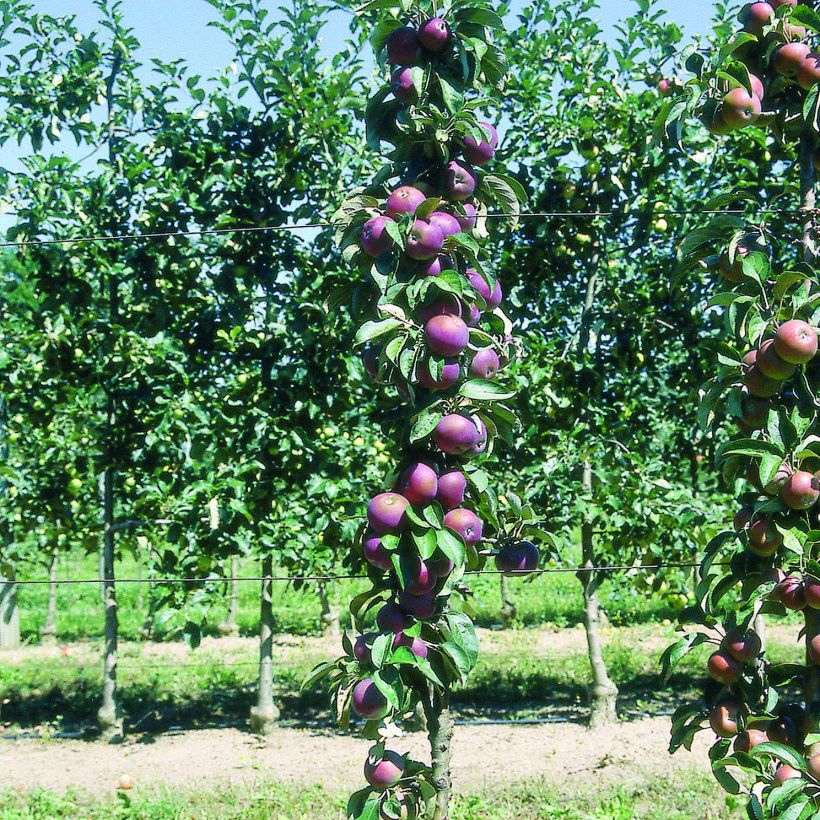

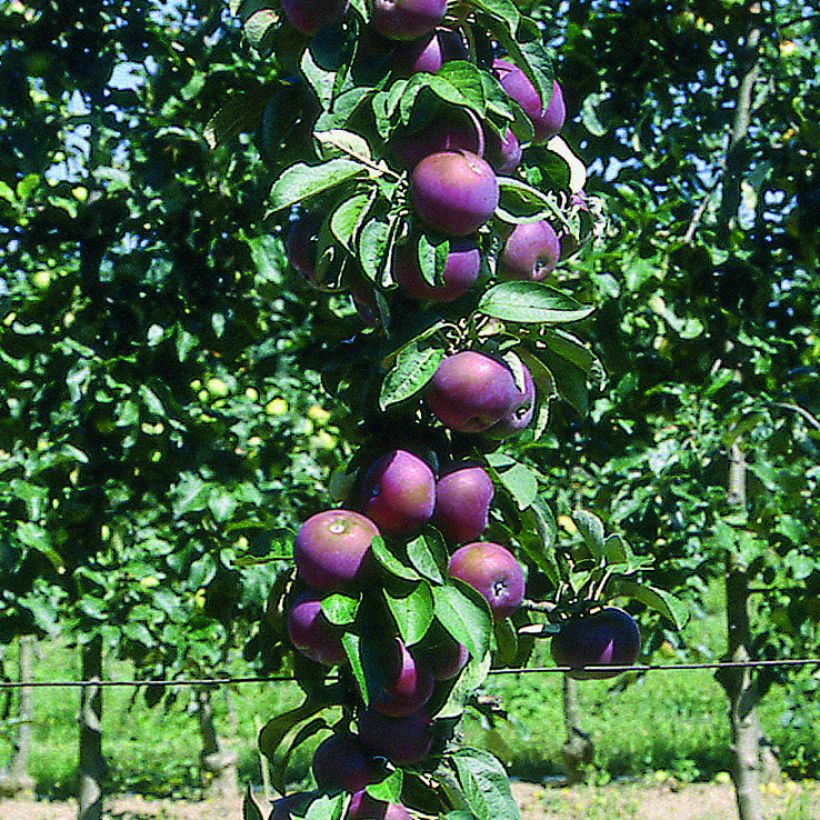

Plant habit
Fruit
Flowering
Foliage
Botanical data
Malus
domestica
Chinon® Delcoblu
Rosaceae
Apple, Orchard apple, Table apple, Cultivated apple
Cultivar or hybrid
M106 (Ready-to-plant root ball - Columnar, 7.5L/10L pot)
Planting and care
Your Chinon® Columnar Apple Tree can be planted very traditionally in open ground. Choose a well-sunny spot, the soil can be slightly chalky or acidic but without excess. Dig a planting hole and simultaneously add organic matter (potting soil, compost...) and a base fertilizer like crushed horn. Do not bury the grafting collar. Stake and water abundantly the first time, even in winter, even if it rains. Fruit trees are ideally planted between October and March, outside the freezing period. You can add a small scoop of wood ash, rich in potash, during winter, this will improve fruiting.
The interest of columnar fruit trees is that they can be planted in outdoor containers. Choose a container of at least 60L. Make sure the container is perforated and create good drainage by filling the bottom with a thick layer of clay pellets or gravel. In pots, your trees will naturally require more regular watering. During winter, move your fruit trees to a sheltered place away from the wind and stop watering during freezing periods. Practice surface dressing at least every two years, which involves replacing at least the topsoil with fresh soil and fertilize before flowering, choose a special fertilizer, not too rich in nitrogen.
Watch out for possible aphid attacks during the season. Harvest takes place in September. Only keep picked fruits. Apples should be stored with the peduncle downwards, on shelves or crates. Preferably choose a completely dark, dry and cool place, but frost-free.
Planting period
Intended location
Care
Planting & care advice
This item has not been reviewed yet - be the first to leave a review about it.
Similar products
Haven't found what you were looking for?
Hardiness is the lowest winter temperature a plant can endure without suffering serious damage or even dying. However, hardiness is affected by location (a sheltered area, such as a patio), protection (winter cover) and soil type (hardiness is improved by well-drained soil).

Photo Sharing Terms & Conditions
In order to encourage gardeners to interact and share their experiences, Promesse de fleurs offers various media enabling content to be uploaded onto its Site - in particular via the ‘Photo sharing’ module.
The User agrees to refrain from:
- Posting any content that is illegal, prejudicial, insulting, racist, inciteful to hatred, revisionist, contrary to public decency, that infringes on privacy or on the privacy rights of third parties, in particular the publicity rights of persons and goods, intellectual property rights, or the right to privacy.
- Submitting content on behalf of a third party;
- Impersonate the identity of a third party and/or publish any personal information about a third party;
In general, the User undertakes to refrain from any unethical behaviour.
All Content (in particular text, comments, files, images, photos, videos, creative works, etc.), which may be subject to property or intellectual property rights, image or other private rights, shall remain the property of the User, subject to the limited rights granted by the terms of the licence granted by Promesse de fleurs as stated below. Users are at liberty to publish or not to publish such Content on the Site, notably via the ‘Photo Sharing’ facility, and accept that this Content shall be made public and freely accessible, notably on the Internet.
Users further acknowledge, undertake to have ,and guarantee that they hold all necessary rights and permissions to publish such material on the Site, in particular with regard to the legislation in force pertaining to any privacy, property, intellectual property, image, or contractual rights, or rights of any other nature. By publishing such Content on the Site, Users acknowledge accepting full liability as publishers of the Content within the meaning of the law, and grant Promesse de fleurs, free of charge, an inclusive, worldwide licence for the said Content for the entire duration of its publication, including all reproduction, representation, up/downloading, displaying, performing, transmission, and storage rights.
Users also grant permission for their name to be linked to the Content and accept that this link may not always be made available.
By engaging in posting material, Users consent to their Content becoming automatically accessible on the Internet, in particular on other sites and/or blogs and/or web pages of the Promesse de fleurs site, including in particular social pages and the Promesse de fleurs catalogue.
Users may secure the removal of entrusted content free of charge by issuing a simple request via our contact form.
The flowering period indicated on our website applies to countries and regions located in USDA zone 8 (France, the United Kingdom, Ireland, the Netherlands, etc.)
It will vary according to where you live:
- In zones 9 to 10 (Italy, Spain, Greece, etc.), flowering will occur about 2 to 4 weeks earlier.
- In zones 6 to 7 (Germany, Poland, Slovenia, and lower mountainous regions), flowering will be delayed by 2 to 3 weeks.
- In zone 5 (Central Europe, Scandinavia), blooming will be delayed by 3 to 5 weeks.
In temperate climates, pruning of spring-flowering shrubs (forsythia, spireas, etc.) should be done just after flowering.
Pruning of summer-flowering shrubs (Indian Lilac, Perovskia, etc.) can be done in winter or spring.
In cold regions as well as with frost-sensitive plants, avoid pruning too early when severe frosts may still occur.
The planting period indicated on our website applies to countries and regions located in USDA zone 8 (France, United Kingdom, Ireland, Netherlands).
It will vary according to where you live:
- In Mediterranean zones (Marseille, Madrid, Milan, etc.), autumn and winter are the best planting periods.
- In continental zones (Strasbourg, Munich, Vienna, etc.), delay planting by 2 to 3 weeks in spring and bring it forward by 2 to 4 weeks in autumn.
- In mountainous regions (the Alps, Pyrenees, Carpathians, etc.), it is best to plant in late spring (May-June) or late summer (August-September).
The harvesting period indicated on our website applies to countries and regions in USDA zone 8 (France, England, Ireland, the Netherlands).
In colder areas (Scandinavia, Poland, Austria...) fruit and vegetable harvests are likely to be delayed by 3-4 weeks.
In warmer areas (Italy, Spain, Greece, etc.), harvesting will probably take place earlier, depending on weather conditions.
The sowing periods indicated on our website apply to countries and regions within USDA Zone 8 (France, UK, Ireland, Netherlands).
In colder areas (Scandinavia, Poland, Austria...), delay any outdoor sowing by 3-4 weeks, or sow under glass.
In warmer climes (Italy, Spain, Greece, etc.), bring outdoor sowing forward by a few weeks.










































